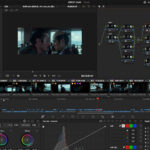Fremont, CA, USA – Tuesday, May 7, 2024 – Blackmagic Design today announced that DaVinci Resolve Studio and DaVinci Resolve Advanced Panel were used for the grading of Takeshi Kitano’s latest film “KUBI.” The grading was performed by Tetsuji Yamashita, a colorist at IMAGICA Entertainment Media Services, using the DaVinci Resolve Advanced Panel.
Written, directed and edited by Takeshi Kitano, “KUBI” is a grand scale historical drama based on the well known event “Honno-ji Incident” from Japan’s Sengoku period. The film, in which humor is present even amidst overwhelming depictions of violence, features an ensemble cast including Hidetoshi Nishijima, Ryo Kase, Shido Nakamura, Tadanobu Asano and Nao Omori.
“I was approached about this project about three years ago. I’ve been watching Kitano’s films since my student days, and they’ve played a significant role in inspiring me to enter this industry, so I was thrilled to be involved,” said colorist Tetsuji Yamashita.
Takeshi Kitano’s films are often associated with the distinctive “Kitano Blue” tone. “Deciding on the look for this film brought a unique tension that wasn’t present in other projects. I had to consider how to interpret the keyword ‘Kitano Blue’ personally. Since the cinematographer for this film was Tsuyoshi Hamada, who is different from Kitano’s usual collaborators, I also explored completely different approaches,” Yamashita explained.
Before shooting, Yamashita created a provisional LUT in DaVinci Resolve and conducted test shoots using that LUT, and further performed test grading in the company’s screening room. Even after shooting began, rush screenings and grading were conducted on the screen several times during breaks in shooting to refine the look. Additionally, to accommodate the busy director’s schedule, grading was applied to offline editing media for key scenes, such as flashbacks.
“Unfortunately, the director Kitano couldn’t be present for the grading sessions, so we worked on creating the look with the cinematographer Tsuyoshi Hamada and the lighting director Hitoshi Takaya. During weeks when shooting was on hold, the director would start offline editing scenes that had already been shot, So I felt that showing the offline editing media also served as a presentation of my look,” Yamashita said.
“At first, the filming was done with a neutral tone, but midway through production, the decision was made to change the overall tone to blue. During filming of some flashback scenes, the decision was made by the cinematography department to lower the color temperature and add a blue tint to give a different tone. Upon seeing the result, Kitano suggested that we use it for the entire film. From then on, the filming was conducted with a color temperature of 4000K, ” Yamashita explained.
Most of the footage shot up to that point had been captured at 5600K, so Yamashita adjusted the color temperature of all the footage using the RAW settings in DaVinci Resolve. After confirming with the director Kitano, they decided to use this direction as the basis for the look, and it was used in the final cut.
Yamashita said: “Shifting the overall color to blue is akin to using a blue filter during filming. As a result, color separation may deteriorate or colors may become muddy. To convey the intentions of the production, including art direction and costumes, while maintaining the blue tone, I carefully adjusted the skin tones and details of costumes,” Yamashita added.
“I have been using DaVinci Resolve since I first became a colorist. It is incredibly user friendly and allows for efficient work even on films with a lot of cuts, which is wonderful. For this project, I graded using the ACES workflow, which DaVinci Resolve allowed me to work on in very flexible manner. Also, Resolve FX settings allow the colorist achieve exactly what they want when adjusting the texture of the image,” concluded Yamashita.
Press Photography
Product photos of DaVinci Resolve Studio, DaVinci Resolve Advanced Panel and all other Blackmagic Design products are available at www.blackmagicdesign.com/media/images
About Blackmagic Design
Blackmagic Design creates the world’s highest quality video editing products, digital film cameras, color correctors, video converters, video monitoring, routers, live production switchers, disk recorders, waveform monitors and real time film scanners for the feature film, post production and television broadcast industries. Blackmagic Design’s DeckLink capture cards launched a revolution in quality and affordability in post production, while the company’s Emmy™ award winning DaVinci color correction products have dominated the television and film industry since 1984. Blackmagic Design continues ground breaking innovations including 6G-SDI and 12G-SDI products and stereoscopic 3D and Ultra HD workflows. Founded by world leading post production editors and engineers, Blackmagic Design has offices in the USA, UK, Japan, Singapore and Australia. For more information, please go to www.blackmagicdesign.com

